Getting Started with Syncfusion Flutter Charts
This section explains the steps required to populate the chart with data, title, data labels, legend, and tooltips. This section covers only the minimal features needed to know to get started with the chart.
To get start quickly with our Flutter chart widget, you can check on this video.
Add Flutter Charts to an application
Create a simple project using the instructions given in the Getting Started with your first Flutter app documentation.
Add dependency
Add the Syncfusion Flutter Chart dependency to your pub spec file.
dependencies:
syncfusion_flutter_charts: ^1.0.0-beta.3Get packages
Run the following command to get the required packages.
$ flutter pub getImport package
Import the following package in your Dart code.
import 'package:syncfusion_flutter_charts/charts.dart';Initialize chart
Once the package has been imported, initialize the chart as a child of any widget. There are two kinds of chart widgets - SfCartesianChart and SfCircularChart. SfCartesianChart is used to render all kinds of charts which need to be plotted in Cartesian coordinates. SfCircularChart can be used to render pie, doughnut and radial bar charts. Here, as we are plotting line chart, initialize SfCartesianChart widget as a child of Container widget.
@override
Widget build(BuildContext context) {
return Scaffold(
body: Center(
child: Container(
//Initialize chart
child: SfCartesianChart()
)
)
);
}
Bind data source
Based on your data, initialize the appropriate axis type and series type. In the series, you need to map the data source and the fields for x and y data points. Here, line series is rendered with category axis that is demonstrated in the following code snippet.
@override
Widget build(BuildContext context) {
return Scaffold(
body: Center(
child: Container(
child: SfCartesianChart(
// Initialize category axis
primaryXAxis: CategoryAxis(),
series: <ChartSeries>[
// Initialize line series
LineSeries<SalesData, String>(
dataSource: [
// Bind data source
SalesData('Jan', 35),
SalesData('Feb', 28),
SalesData('Mar', 34),
SalesData('Apr', 32),
SalesData('May', 40)
],
xValueMapper: (SalesData sales, _) => sales.year,
yValueMapper: (SalesData sales, _) => sales.sales
)
]
)
)
)
);
}
class SalesData{
SalesData(this.year, this.sales);
final String year;
final double sales;
}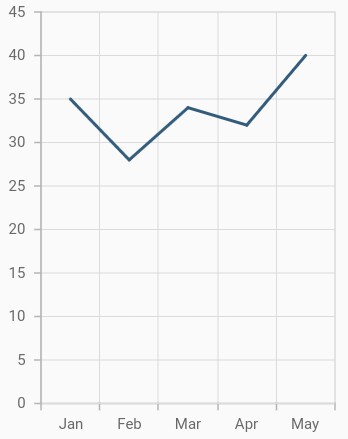
Add title
You can add a title to the chart to provide quick information to users about the data plotted in the chart. The title to chart can be set as demonstrated in the following code snippet.
@override
Widget build(BuildContext context) {
return Scaffold(
body: Center(
child: Container(
child: SfCartesianChart(
// Chart title text
title: ChartTitle(text: 'Half yearly sales analysis'),
// Initialize category axis
primaryXAxis: CategoryAxis(),
series: <ChartSeries>[
// Initialize line series
LineSeries<SalesData, String>(
dataSource: [
// Bind data source
SalesData('Jan', 35),
SalesData('Feb', 28),
SalesData('Mar', 34),
SalesData('Apr', 32),
SalesData('May', 40)
],
xValueMapper: (SalesData sales, _) => sales.year,
yValueMapper: (SalesData sales, _) => sales.sales)
]
)
)
)
);
}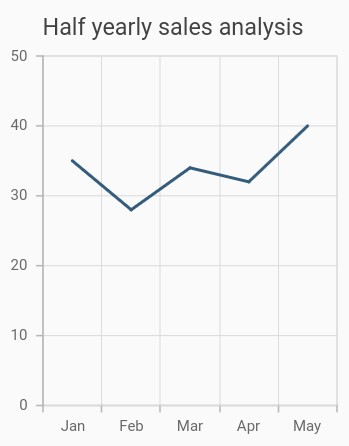
Enable data labels
You can add data labels to improve the readability of the chart using the SfCartesianChart.dataLabelSettings property.
@override
Widget build(BuildContext context) {
return Scaffold(
body: Center(
child: Container(
child: SfCartesianChart(
title: ChartTitle(text: 'Half yearly sales analysis'),
// Initialize category axis
primaryXAxis: CategoryAxis(),
series: <ChartSeries>[
// Initialize line series
LineSeries<SalesData, String>(
dataSource: [
// Bind data source
SalesData('Jan', 35),
SalesData('Feb', 28),
SalesData('Mar', 34),
SalesData('Apr', 32),
SalesData('May', 40)
],
xValueMapper: (SalesData sales, _) => sales.year,
yValueMapper: (SalesData sales, _) => sales.sales,
// Render the data label
dataLabelSettings:DataLabelSettings(isVisible : true)
)
]
)
)
)
);
}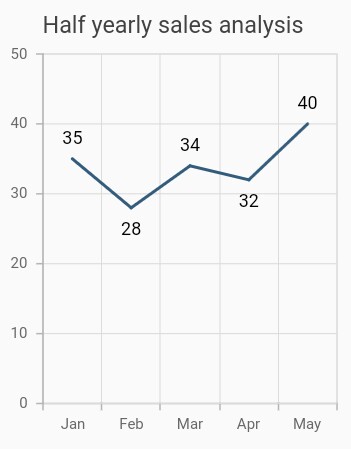
Enable legend
The legend provides information about the series rendered in the chart.
You can use legend in chart by setting the isVisible property to true in SfCartesianChart.legend.
Additionally, you need to set label for each series using the series.name property. The labels will be displayed in corresponding legends.
@override
Widget build(BuildContext context) {
return Scaffold(
body: Center(
child: Container(
child: SfCartesianChart(
// Enables the legend
legend: Legend(isVisible: true),
// Initialize category axis
primaryXAxis: CategoryAxis(),
series: <ChartSeries>[
// Initialize line series
LineSeries<SalesData, String>(
dataSource: [
// Bind data source
SalesData('Jan', 35),
SalesData('Feb', 28),
SalesData('Mar', 34),
SalesData('Apr', 32),
SalesData('May', 40)
],
xValueMapper: (SalesData sales, _) => sales.year,
yValueMapper: (SalesData sales, _) => sales.sales,
name: 'Sales'
)
]
)
)
)
);
}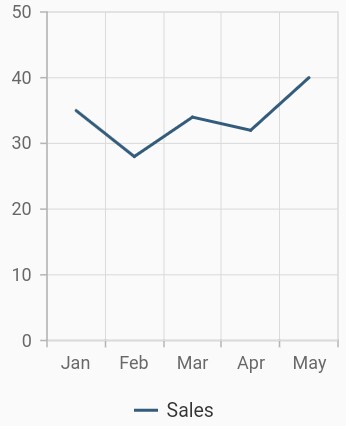
Enable tooltip
The tooltip is used when you cannot display information using the data labels due to space constraints.
The tooltipBehavior property in chart is used to enable and customize the tooltip for all the series whereas the enableTooltip property in series is used to toggle the tooltip visibility of each series. The tooltip is enabled as demonstrated in the following code snippet.
@override
Widget build(BuildContext context) {
return Scaffold(
appBar: AppBar(
title: Text(widget.title),
),
body: Center(
child: Container(
child: SfCartesianChart(
// Enables the tooltip for all the series in chart
tooltipBehavior: TooltipBehavior(enable: true),
// Initialize category axis
primaryXAxis: CategoryAxis(),
series: <ChartSeries>[
// Initialize line series
LineSeries<SalesData, String>(
// Enables the tooltip for individual series
enableTooltip: true,
dataSource: [
// Bind data source
SalesData('Jan', 35),
SalesData('Feb', 28),
SalesData('Mar', 34),
SalesData('Apr', 32),
SalesData('May', 40)
],
xValueMapper: (SalesData sales, _) => sales.year,
yValueMapper: (SalesData sales, _) => sales.sales
)
]
)
)
)
);
}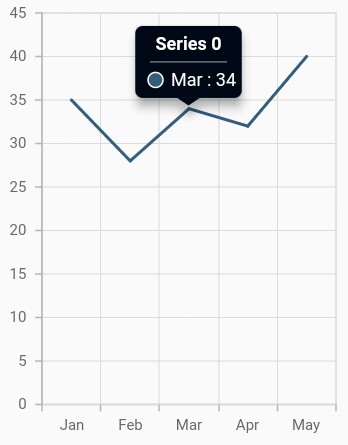
You can find the complete getting started sample from this link.